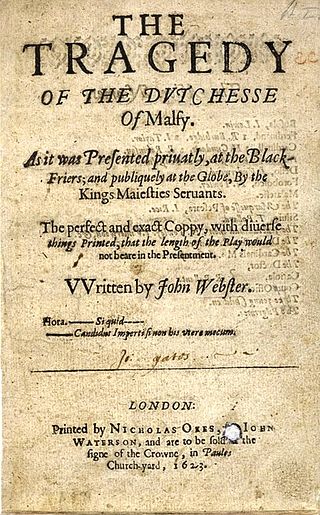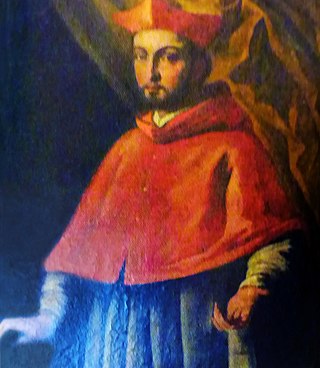Related Research Articles

Matteo Bandello was an Italian writer, soldier, Dominican friar and bishop, best known for his novellas. His collection of 214 novellas made him the most popular short-story writer of his day.

Antonio Gamberelli (1427–1479), nicknamed Antonio Rossellino for the colour of his hair, was an Italian Renaissance sculptor. His older brother, from whom he received his formal training, was the sculptor and architect Bernardo Rossellino.

The Duchess of Malfi is a Jacobean revenge tragedy written by English dramatist John Webster in 1612–1613. It was first performed privately at the Blackfriars Theatre, then later to a larger audience at The Globe, in 1613–1614.

Isabella of Aragon, also known as Isabella of Naples, was by marriage Duchess of Milan and suo jure Duchess of Bari.

The House of Piccolomini is the name of an Italian noble family, Patricians of Siena, who were prominent from the beginning of the 13th century until the 18th century. The family achieved the recognized titles of Pope of the Catholic Church, Prince of the Holy Roman Empire, Grandee of Spain, and Duke of Amalfi. The family is also featured in Florentine Histories, a book written by Niccolò Machiavelli, where he describes the reign of Pope Pius II, who had allied himself with the Venetians and Prince Vlad Dracula, to wage a war against the Sultan of the Ottoman empire.
Medieval Amalfi was ruled, in the tenth and eleventh centuries, by a series of dukes, sometimes called dogi, corresponding with the republic of Venice, a maritime rival throughout the Middle Ages. Before the title of Duke of Amalfi was formally established in 957, various patricians governed the territory. Amalfi established itself as one of the earliest maritime trading powers renowned throughout the Mediterranean, considered for two centuries, one of the most powerful of the maritime republics.

Antonio Beccadelli (1394–1471), called Il Panormita, was an Italian poet, canon lawyer, scholar, diplomat, and chronicler. He generally wrote in Latin. Born in Palermo, he was the eldest son of the merchant Enrico di Vannino Beccadelli, who had played an active role in Sicilian politics, serving as Praetor of Palermo in 1393.

Atrani is a city and comune on the Amalfi Coast in the province of Salerno in the Campania region of south-western Italy. It is located to the east of Amalfi, several minutes' drive down the coast.
The Duchess of Malfi is an opera in three acts by the British composer Stephen Oliver, based on the eponymous play by John Webster. Oliver originally wrote this opera, his ninth in 1971, at age 21, for a production at the Oxford Playhouse on commission from the Oxford University Opera Club. The premiere was on November 23, 1971, with the following cast members:

Giulio Antonio Acquaviva was an Italian nobleman and condottiere. He was 7th Duke of Atri and 1st of Teramo, Count of Conversano and San Flaviano and Lord of Padula and Roseto.
Joanna of Aragon (1479–1555), historically known as Joanna the Mad, was the nominal Queen of Castile and of Aragon.

Fernando de Aragón y Guardato, 1st Duke of Montalto was the eldest bastard son of king Ferdinand I of Naples and Diana Guardato, one of his mistresses.

Luigi d'Aragona (1474–1519) was an Italian Roman Catholic cardinal. He had a highly successful career in the church, but his memory is affected by the allegation that he ordered the murder of his own sister and two of her children.

The church of Santi Severino e Sossio and the annexed monastery are located on via Bartolommeo Capasso in Naples, Italy.

Maria d'Aragona was the daughter of Duke Ferdinando di Montalto and Catalina Cardona and the granddaughter of King Ferdinand I of Naples, also called King Ferrante. As a child, Maria d’Aragona grew up in a castle with the poet Vittoria Colonna, who had married d'Avalo's nephew. It was here that Maria met Sannazaro, Tansillo, and Bernardo Tasso who would entertain her in later life at her own salons in Naples, Milan, and Pavia.
Giovanna d'Aragona, Duchess of Amalfi (1478–1510) was an Italian aristocrat, regent of the Duchy of Amalfi during the minority of her son from 1498 until 1510. Her tragic life inspired several works of literature, most notably John Webster's play, The Duchess of Malfi.

Alfonso I Piccolomini (1468–1498) was Duke of Amalfi. He was the son of Antonio Piccolomini, who had been granted the title Duke of Amalfi in 1461, for his services to king Ferdinand I of Naples. His mother was Maria Marzano d'Aragona. In 1490 he married Giovanna d'Aragona.

Castello di Gagliano Aterno is a Middle Ages castle in Gagliano Aterno, Province of L'Aquila (Abruzzo).
Enrico "Arrigo" d'Aragona was an illegitimate son of the King of Naples, Ferrante I of Aragon. Despite the circumstances of his birth he was well regarded by his father and granted the title of Marchese (Marquis) of Gerace in 1473. He was the father of Luigi and Giovanna.

The d'Afflitto family is an ancient princely family originally from Amalfi, documented since the IX century, and spread throughout southern Italy.
References
- ↑ Matteo Bandello, «Il signor Antonio Bologna sposa la duchessa di Malfi e tutti dui sono ammazzati», Novelle, Novella XXVI. In: La prima parte de le novelle del Bandello. Tomo secondo, Londra: presso Riccardo Bancker (i.e. Livorno: Tommaso Masi), 1791, pp. 212 ff.
- 1 2 3 Leah Marcus (ed), The Duchess of Malfi, Bloomsbury, pp.17ff.
- 1 2 Giacomo Della Morte, Cronica di Napoli di Notar Giacomo; pubblicata per cura di Paolo Garzilli, Napoli: Stamperia Reale, 1845, pp. 331
- ↑ Scipione Ammirato, Delle famiglie nobili napoletane di Scipione Ammirato parte prima, le quali per leuar'ogni gara di precedenza sono state poste in confuso, In Fiorenza: appresso Giorgio Marescotti, 1580, II, pp. 49-50.
- 1 2 Felicita De Negri, «DI BOLOGNA, Antonio». In: Dizionario Biografico degli Italiani , Vol. IX, Roma: Istituto dell'Enciclopedia Italiana, 1968.
- ↑ Charles R. Forker, Skull beneath the Skin: The Achievement of John Webster, Southern Illinois University Press, Carbondale, IL., 1986, p.115.
- ↑ Matteo Camera, Memorie storico-diplomatiche dell'antica città e Ducato di Amalfi: cronologicamente ordinate e continuate sino al secolo XVIII, Salerno: Stabilimento Tipografico Nazionale, 1876, pp. 81-82.